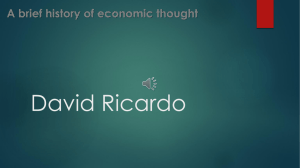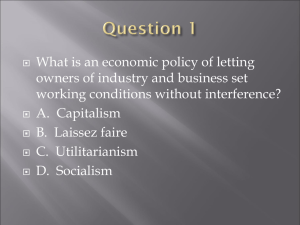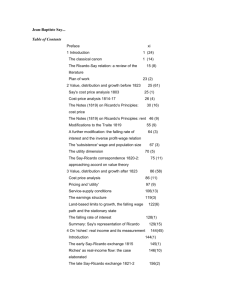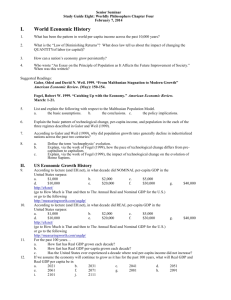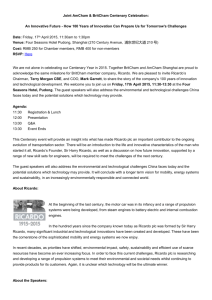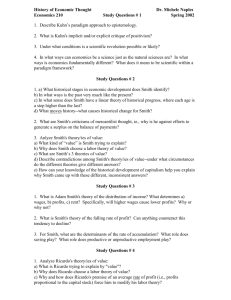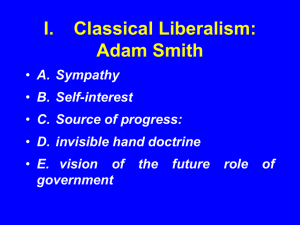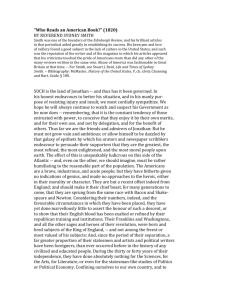Key Concepts and
advertisement
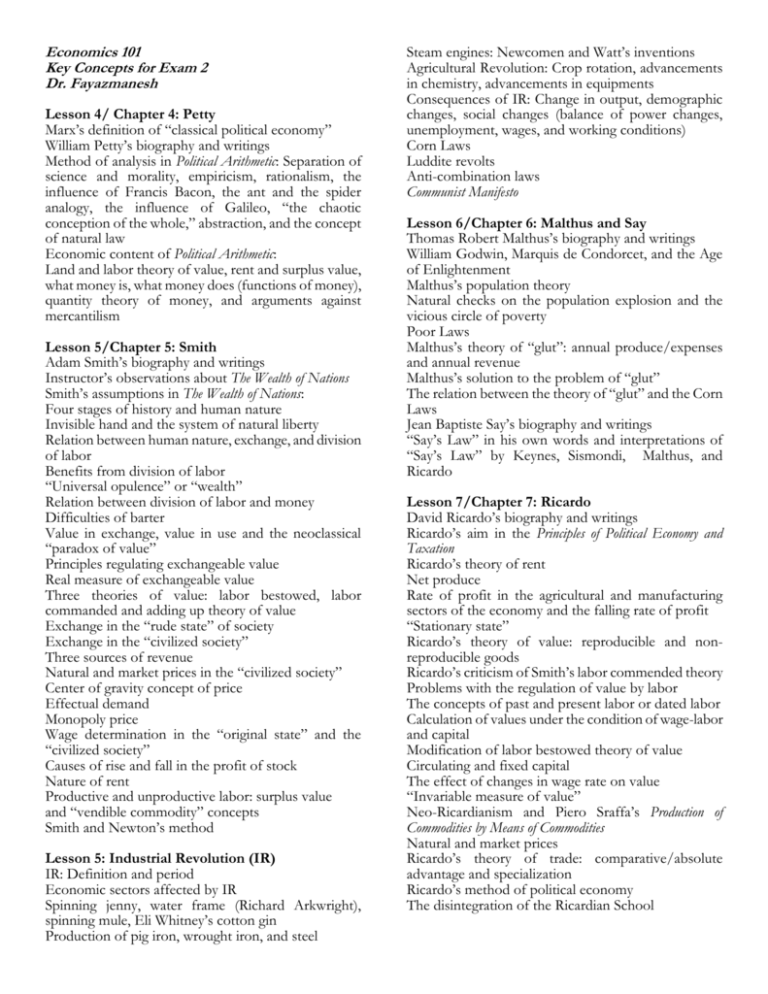
Economics 101 Key Concepts for Exam 2 Dr. Fayazmanesh Lesson 4/ Chapter 4: Petty Marx’s definition of “classical political economy” William Petty’s biography and writings Method of analysis in Political Arithmetic: Separation of science and morality, empiricism, rationalism, the influence of Francis Bacon, the ant and the spider analogy, the influence of Galileo, “the chaotic conception of the whole,” abstraction, and the concept of natural law Economic content of Political Arithmetic: Land and labor theory of value, rent and surplus value, what money is, what money does (functions of money), quantity theory of money, and arguments against mercantilism Lesson 5/Chapter 5: Smith Adam Smith’s biography and writings Instructor’s observations about The Wealth of Nations Smith’s assumptions in The Wealth of Nations: Four stages of history and human nature Invisible hand and the system of natural liberty Relation between human nature, exchange, and division of labor Benefits from division of labor “Universal opulence” or “wealth” Relation between division of labor and money Difficulties of barter Value in exchange, value in use and the neoclassical “paradox of value” Principles regulating exchangeable value Real measure of exchangeable value Three theories of value: labor bestowed, labor commanded and adding up theory of value Exchange in the “rude state” of society Exchange in the “civilized society” Three sources of revenue Natural and market prices in the “civilized society” Center of gravity concept of price Effectual demand Monopoly price Wage determination in the “original state” and the “civilized society” Causes of rise and fall in the profit of stock Nature of rent Productive and unproductive labor: surplus value and “vendible commodity” concepts Smith and Newton’s method Lesson 5: Industrial Revolution (IR) IR: Definition and period Economic sectors affected by IR Spinning jenny, water frame (Richard Arkwright), spinning mule, Eli Whitney’s cotton gin Production of pig iron, wrought iron, and steel Steam engines: Newcomen and Watt’s inventions Agricultural Revolution: Crop rotation, advancements in chemistry, advancements in equipments Consequences of IR: Change in output, demographic changes, social changes (balance of power changes, unemployment, wages, and working conditions) Corn Laws Luddite revolts Anti-combination laws Communist Manifesto Lesson 6/Chapter 6: Malthus and Say Thomas Robert Malthus’s biography and writings William Godwin, Marquis de Condorcet, and the Age of Enlightenment Malthus’s population theory Natural checks on the population explosion and the vicious circle of poverty Poor Laws Malthus’s theory of “glut”: annual produce/expenses and annual revenue Malthus’s solution to the problem of “glut” The relation between the theory of “glut” and the Corn Laws Jean Baptiste Say’s biography and writings “Say’s Law” in his own words and interpretations of “Say’s Law” by Keynes, Sismondi, Malthus, and Ricardo Lesson 7/Chapter 7: Ricardo David Ricardo’s biography and writings Ricardo’s aim in the Principles of Political Economy and Taxation Ricardo’s theory of rent Net produce Rate of profit in the agricultural and manufacturing sectors of the economy and the falling rate of profit “Stationary state” Ricardo’s theory of value: reproducible and nonreproducible goods Ricardo’s criticism of Smith’s labor commended theory Problems with the regulation of value by labor The concepts of past and present labor or dated labor Calculation of values under the condition of wage-labor and capital Modification of labor bestowed theory of value Circulating and fixed capital The effect of changes in wage rate on value “Invariable measure of value” Neo-Ricardianism and Piero Sraffa’s Production of Commodities by Means of Commodities Natural and market prices Ricardo’s theory of trade: comparative/absolute advantage and specialization Ricardo’s method of political economy The disintegration of the Ricardian School Economics 101 Possible Essay Questions Dr. Fayazmanesh 1. Marx is credited for having coined the term “classical political economy.” What did he mean by that expression? How do the writings of such individuals as Petty, Smith and Ricardo exemplify the concept? Why did he not consider Malthus and Say as “classical political economists”? 8. What were the social, political and economic consequences of the Industrial Revolution in England? 9. What was Malthus’s theory of population? What were the “natural checks” on the growth of population? What political and economic aims were behind Mathus’s theory and argument? 10. Explain “Say’s Law” in his own words and discuss different interpretations of “Say’s Law” by Keynes, Sismondi, Malthus, and Ricardo. 2. Discuss, as I did in class and as your textbook does partially, four important methodological aspects of Petty’s Political Arithmetic. 11. Explain David Ricardo’s theory of rent (make sure to give a numerical example). What is the significance of this theory for the rate of profit in economy? 3. Adam Smith had certain presuppositions concerning the stages of history and human nature. Define and explain these presuppositions. 12. What was Ricardo's criticism of Smith's theory of value and how did his own theory of value differ from that of Adam Smith? 4. How did money develop according to Adam Smith? 13. Using a numerical example of Ricardo’s exchange between the “deer and beaver hunters,” explain how the simple rate of exchange between deer and beavers is modified in an economy dominated by wage-labor and capital. 5. According to the neoclassical economists, the famous passage of Smith concerning “Value” contains a paradox. According to your instructor, there is absolutely nothing paradoxical in Smith’s passage and the neoclassicals faked the “paradox.” Explain both arguments. 6. Explain the three distinct theories of value found in Smith’ The Wealth of Nations. 7. Explain the distinction between “natural and market price” in Smith and why the market price may diverge from the natural price. 14. Using a numerical example of Ricardo’s exchange between the “deer and beaver hunters,” explain how a change in the wage and profit rate would change the value of commodities in industries with different ratios of circulating capital to fixed capital. 15. Using a numerical example, explain Ricardo’s socalled the “law of comparative advantage” and the benefits from trade.
